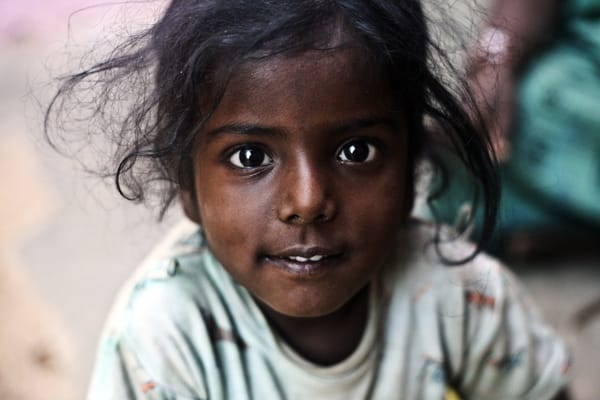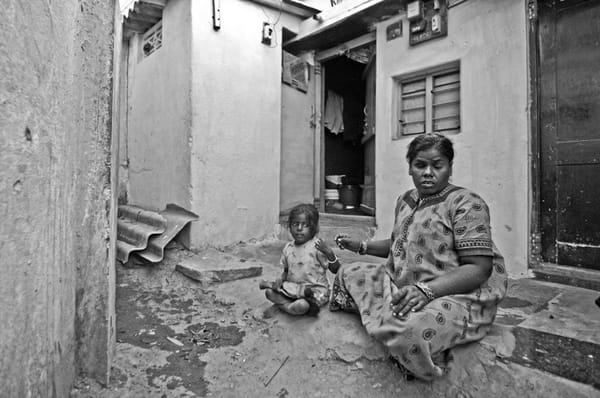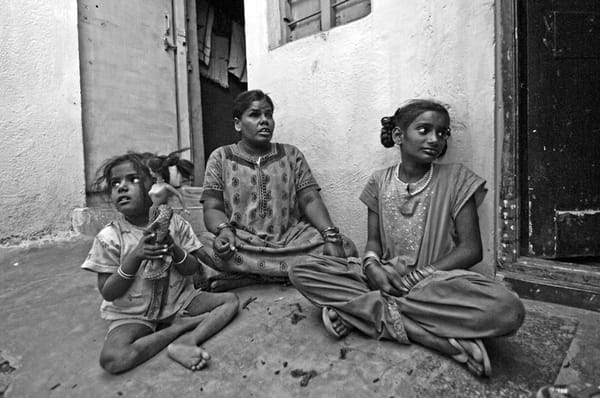
Meghala, who died on 17 July 2013, due to malnutrition coupled with pneumonia. Pic: Javed Iqbal
“Poverty is the worst form of violence.”
– Mohandas Karamchand Gandhi
There were two little girls in Bangalore. They lived quite far away from each other, and never knew the other existed. They were diagnosed with similar illnesses in a gap of two weeks – one having contracted pneumonia and the other affected with pneumonitis (a milder form of pneumonia).
Both of them weighed exactly 11.8 kgs at the time of diagnosis. One lived in a slum, and the other in a middle-class neighborhood.
One was three years old, healthy, had access to nutritious foods and timely, quality health-care. The other was six years old, severely malnourished all her life, without access to nutritious food or timely health-care.
The six-year old Meghala died of pneumonia on July 17th 2013, after a week-long battle. My three-year old daughter is recovering well from pneumonitis, with little reason to worry.
16 July, 7 pm
Responding to an SOS-call from a friend, I had volunteered to spend the evening with Meghala’s family at the hospital while my friend, who had helped admit Meghala to the Baptist Hospital in Hebbal, took a break.
A look at the ICU visitor’s ledger while entering my contact details left gave me a reality check. Among the dozen or so entries, there were at least 4 entries with comments saying “Expired”. In the waiting area outside, Ruth, Meghala’s 11-year-old sister and her mother Murugamma refused to eat anything while Meghala was fighting with death in the Paediatric ICU.
17 July, 7 am
Murugamma still refused to partake anything but tea, and wanted me to take a look at Meghala before leaving for work.
Meghala’s breathing seemed more rushed than ever. Or was it just me?
17 July, 4.45 pm
A terse call telling me to rush immediately confirmed the news I was dreading the most. I had even missed the text message sent 15 minutes earlier, telling me that Meghala was bleeding into her lungs and out of her mouth and that one more heavy bleed would be fatal.
At the hospital, Ruth broke down as she saw me, even as she cried that Meghala’s life could have been spared for her own. This 13-year-old’s childhood had probably never been hers, having earlier worked in an agarbathi factory till it took a toll on her health, taking care of her visually-impaired mom and under-nourished younger sister.
Later that evening, a few well-wishers from the basti showed up at the funeral, lending a comforting shoulder to Murugamma and Ruth, but also silencing the wailing women at the insistence of the pastor, denying them the chance to give vent to their emotions. The others soon disappeared, leaving Murugamma and Ruth seated on the pavement outside the cemetery, with blank expressionless faces.
I went with them to their house, the stories I heard made me feel as if Meghala was everywhere. The red brick near the door where she would sit and interrogate people who came by. The corner inside where she would sleep. The remaining few cough-drops and ineffective tablets. And, finally, I saw her for the first time as the child that she had been. A slightly chubby little girl stared at me through her passport-sized photo, one of the precious few her mom had. A sledge-hammer started to pound at my chest.

Meghala and Murugamma. Pic: Javed Iqbal
The cracks that claimed Meghala
Meghala’s death might not have woken up the system, but has definitely ruffled enough feathers for them to feel the heat. Murugamma has been hounded daily not just by the media, but also by various Anganwaadi officials and PHC workers. Even the State Minister for Women and Child Welfare, Umashree along with the Health Minister U T Khadar paid her a visit.
Minister Umashree was quick to point out in an Assembly discussion the next day that “Meghala died due to pneumonia and not malnutrition” and concluded that an enquiry into her death was unnecessary. According to her, Meghala’s weight went from 10.8 kgs to 11.2 kgs thanks to the nutritious food and care from the local ICDS services. Further, she stated that her family’s poverty and pitiable and unhygienic conditions led to her developing the infection that caused her death.
Murugamma lost her eyesight when she was 9, after a debilitating bout of smallpox. When Meghala was just a few months old, she lost her husband. With no other means, Murugamma would resort to begging at times, but that could not prevent Meghala from remaining under-nourished all these years.
Ruth, while not nearly as malnourished, is still underweight for her age and is also anemic. The mid-day meals from the local Anganwaadi aside, it was only the personal support provided by some activists, in providing the family with dry rations whenever possible, helped Meghala’s health improve over the last year, becoming increasingly mobile and much more lively.
Malnutrition or pneumonia or Both?
Pneumonia is treatable. Chronic and severe malnourishment combined with pneumonia is a lot less so. And that’s what ultimately killed her. The medical summary report Meghala’s death did report the cause of death as pneumonia. But it is blatantly evident that Meghala was a severely malnourished child, weighing less than 12 kgs at 6 years of age even at the time of her hospitalisation (Refer this chart here.)
A simple Google search is all it takes to learn that “children with pneumonia and moderate or severe malnutrition are at higher risk of death”. Up to sixteen studies have reported that for severe malnutrition, the risk for malnourished children is 121 times that of the risk for non-malnourished children. This paper goes as far as to conclude that “pneumonia and malnutrition are two of the biggest killers in childhood” and that “Guidelines for the care of children with pneumonia and malnutrition need to take into account this strong and often lethal association if they are contribute to the UN Millennium Development Goal 4, aiming for substantial reductions in childhood mortality”.
It appears that even the Chief Minister Siddaramaiah would need to spend some time meeting medical professionals and the concerned health departments to understand public health issues better, as he stood by Minister Umashree’s conclusion and refused the Opposition Leader’s demand for an enquiry into the death.

Meghala, Murugamma and Ruth, in front of their house. Pic: Javed Iqbal
Incorrect initial diagnosis and treatment
The local clinic where Meghala was first taken to after reporting fever, multiple bouts of coughing, and irregular breathing, prescribed cough-drops and anti-spasmodic tablets, without once checking her for pneumonia or TB, as the symptoms would have ordinarily necessitated.
A friend of mine, a doctor, reviewed Meghala’s records and remarked how weak she had been even as when was tested at the Baptist Hospital for the first time. She also mentioned that the time when Meghala was taken to the clinic would have been the “golden hour” and a quick diagnosis with immediate commencement of antibiotics treatment might have made the difference.
17 July, 10 pm
The news of the child’s death had evidently not filtered through the basti yet. A sprightly young girl came bounding our way, wanting to know where the little child was, the one who had been admitted to the hospital. My friend Gee’s weary response, “she’s dead” didn’t even reach her, as she ran away smiling, hoping to catch her friend in her house.
Even as we bade goodbye to Murugamma, a puffy-eyed Ruth came along with us to the street, and in that warm manner of hers, told me to ride home safe.
*****
Earlier, at the cemetery, even as mud started to rain down on the white coffin, the pastor had thanked the Lord for giving life to the little girl, clothing her and feeding her.
A life where she seldom had food to eat, and one that ultimately got snuffed out way too soon.
I didn’t know whether to laugh or cry.
Meghala was not unfortunate in being born into a family without access to financial and social capital. Her real crime was being born in a city, state, country and society which had shirked off its responsibilities towards its most under-privileged and hung them out to dry.
Terrible. The connection between hunger and health is well documented, and also plainly obvious.
A case like this with two children in the same place contracting almost the same illness but having opposite outcomes painfully brings this point home.
Why would the health minister and chief minister rather deny this and lay the blame on hygiene? Whom are they serving?
I want to know where the church and pastor were when this family was begging on the street…. Why weren’t they provided with food , education and living quaters…. Yes politician can say anything they please…we as citizens of this country have learnt not to expect much from them …. But why did the church to which they belong only come the bury the child…. It is the duty of churches and any religious body/ institution to make sure that children are protected and provided for…..
In India, if you are poor, the religion you belong to does not matter. It is the privilege of the rich and political to be religious. In India, even God is differentially accessible depending on whether you are rich or poor. Have we not heard of churches and temples for the “lower” castes? Which religious prayer hall (temple or church) have you ever visited where the rich and the poor mingle in front of God as His/Her equal children? That is why I do not support to religious entities. In India, religion is as depraved, corrupt and ruthless as politics. If God is what He/She is supposed to be, I am sure even God has shed away religion in India. My God has…